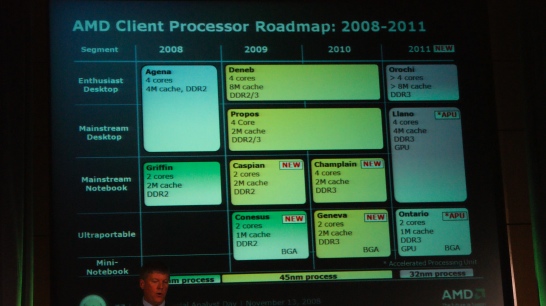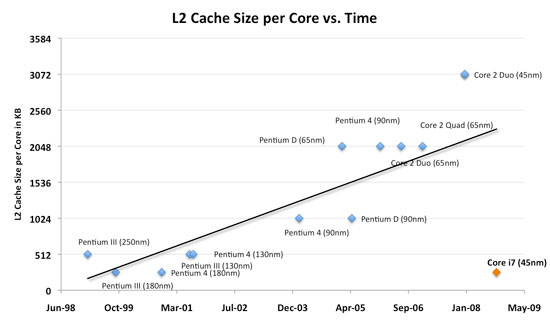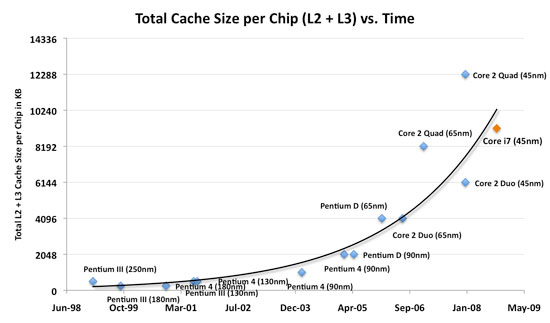Nehalem Part 3: The Cache Debate, LGA-1156 and the 32nm Future
by Anand Lal Shimpi on November 19, 2008 8:00 PM EST- Posted in
- CPUs
Another Part? Oh there will be more
In an unexpected turn of events I found myself deep in conversation with many Intel engineers as well as Pat Gelsinger himself about the design choices made in Nehalem. At the same time, Intel just released its 2009 roadmap which outlined some of the lesser known details of the mainstream LGA-1156 Nehalem derivatives.
I hadn’t planned on my next Nehalem update being about caches and mainstream parts, but here we go. For further reading I'd suggest our first two Nehalem articles and the original Nehalem architecture piece.
Nehalem’s Cache: More Controversial Than You’d Think
I spoke with Ronak Singhal, Chief Architect on Nehalem, at Intel’s Core i7 launch event last week in San Francisco and I said to him: “I think you got the cache sizes wrong on Nehalem”. I must be losing my shyness.

He thought I was talking about the L3 cache and asked if I meant it needed to be bigger, and I clarified that I was talking about the anemic 256KB L2 per core.
We haven’t seen a high end Intel processor with only 256KB L2 per core since Willamette, the first Pentium 4. Since then Intel has been on a steady ramp upwards as far as cache sizes go. I made a graph of L2 cache size per core of all of the major high end Intel cores for the past decade:
For the most part we’ve got a linear trend, there are a few outliers but you can see that earlier in 2008 you’d expect Intel CPUs to have around 2 - 3MB of L2 cache per core. Now look at the lower right of the chart, see the little orange outlier? Yeah, that’s the Core i7 with its 256KB L2 cache per core, it’s like 2002 - 2007 never happened.
If we look at total on-chip cache size however (L2 + L3), the situation is very different:
Now we’ve got an exponential growth of cache size, not linear, and all of the sudden the Core i7 conforms to societal norms. To understand why, we have to look at what happened around 2005 - 2006: Intel started shipping dual-core CPUs. As core count went up, so did the total amount of cache per chip. Dual core CPUs quickly started shipping with 2MB and 4MB of cache per chip and the outgoing 45nm quad-core Penryns had 12MB of L2 cache on a single package.
The move to multi-core chip designs meant that the focus was no longer on feeding the individual core, but making sure all of the cores on the chip were taken care of. It’s all so very socialist (oh no! ;) ).
Nehalem was designed to be a quad-core product, but also one that’s able to scale up to 8 cores and down to 2 cores. Intel believes in this multi-core future so designing for dual-core didn’t make sense as eventually dual-core will go away in desktops, a future that’s still a few years away but a course we’re on nonetheless.

AMD's shift to an all quad-core client roadmap
Intel is pushing the shift to quad-core, much like AMD is. By 2010 all of AMD’s mainstream and enthusiast CPUs will be quad-core with the ultra low end being dual-core, a trend that will continue into 2011. The shift to quad-core makes sense, unfortunately today very few consumer applications benefit from four cores. I hate to keep re-using this same table but it most definitely applies here:
Back when AMD introduced its triple-core Phenom parts I put together a little table illustrating the speedup you get from one, two and four cores in SYSMark 2007:
| SYSMark 2007 Overall | E-Learning | Video Creation | Productivity | 3D | |
| Intel Celeron 420 (1 core, 512KB, 1.6GHz) | 55 | 52 | 55 | 54 | 58 |
| Intel Celeron E1200 (2 cores, 512KB, 1.6GHz) | 76 | 68 | 91 | 70 | 78 |
| % Increase from 1 to 2 cores | 38% | 31% | 65% | 30% | 34% |
| Intel Core 2 Duo E6750 (2 cores, 4MB, 2.66GHz) | 138 | 147 | 141 | 120 | 145 |
| Intel Core 2 Quad Q6700 (4 cores, 8MB, 2.66GHz) | 150 | 145 | 177 | 121 | 163 |
| % Increase from 2 to 4 cores | 8.7% | 0% | 26% | 1% | 12% |
Not only are four cores unnecessary for most consumers today, but optimizing a design for four cores by opting for very small, low latency L2 caches and a large, higher latency L3 cache for the chip isn’t going to yield the best desktop performance.
A Nehalem optimized for two cores would have a large L2 cache similar to what we saw happening on the first graph, but one optimized for four or more cores would look like what the Core i7 ended up being. What’s impressive is that Intel, in optimizing for a quad-core design, was still able to ensure that performance either didn’t change at all or improved in applications that aren’t well threaded.
Apparently the L2 cache size was and still is a controversial issue within Intel, many engineers still feel like it is too small for current workloads. The problem with making it larger is not just one of die size, but also one of latency. Intel managed to get Nehalem’s L2 cache down to 10 cycles, the next bump in L2 size would add another 1 - 2 cycles to its latency. At 512KB per core, 20% longer to access the cache was simply unacceptable to the designers.
In fact, going forward there’s no guarantee that the L2 caches will see growth in size, but the focus instead may be on making the L3 cache faster. Right now the 8MB L3 cache takes around 41 cycles to access, but there’s clearly room for improvement - getting a 30 cycle L3 should be within the realm of possibility. I pushed Ronak for more details on how Intel would achieve a lower latency L3, but the best I got was “microarchitectural tweaks”.
As I mentioned before, Ronak wanted the L3 to be bigger on Nehalem; at 8MB that’s only 2MB per core and merely sufficient in his eyes. There are two 32nm products due out in the next 2 years, I suspect that at least one of them will have an even larger L3 to continue the exponential trend I showed in the second chart above.
Could the L2 be larger? Sure. But Ronak and his team ultimately felt that the tradeoff between size/latency was necessary for what Intel’s targets were with Nehalem. And given its 0 - 60% performance increase, clock for clock, over Penryn - I can’t really argue.












33 Comments
View All Comments
blyndy - Thursday, November 20, 2008 - link
Yeah I think that Intel has failed to be consistant between Penryn/Nehalem, or at least bit off more than it could chew...I mean, tick-tock is fine and all, but Penryn has really held up as an ideal architecture, as something to grow off, not as something that should be immediately succeeded by 'the biggest architectural redesigns since the Pentium 1'. After all Core/2 IS the fruit of the P3/Pentium M. Nehalem on the other hand smells unpleasantly P4-like, due in large part to hyperthreading.
HT's something that you either see as 'reduces single thread performance, consumes transistors adds arch bloat and adds heat' or as 'OMG MOAR CPUs IN TASK MANAGERZOMG!!!'. And it's funny because at the end of the day it still runs into the same question as the core-count issue --'are these additional execution units adequately utilisable by a DIVERSE set of applications (i.e. NOT JUST vid encode...)?'. Because we know threading is HARD.
OK I'll come clean-I just what to know when are they going to dust off the wolfdale masks and shrink 'em onto 32nm? :D
esgreat - Thursday, November 20, 2008 - link
Well tell me where does the mainstream user want for in performance other THAN video encoding and image processing?Games? Games have shown to be much more limited to GPU side. Most CPU enhancements can't really make huge impacts on games nowadays. This is unless they try to utilize more cores, which is what they have done: provide the hardware so that software could use it. The software is fast right now because things like SSE were introduced years ago (although they weren't beneficial then).
As for video encoding, cutting down encoding time from 30 minutes to 10 minutes IS A BIG DEAL. And this is one application where many users (non gamers) would really use.
Enabling of multicore now means fantastic applications in the future.
cocoviper - Thursday, November 20, 2008 - link
Pretty good read.I'm hoping we can get some more detailed info about Intel's 32nm process in the next couple months- especially what they're planning to do with Atom and 32nm.
CEO Ballmer - Wednesday, November 19, 2008 - link
AMD is still in the game?I had written them off!
http://fakesteveballmer.blogspot.com">http://fakesteveballmer.blogspot.com
Derbalized - Thursday, November 20, 2008 - link
AMD is still in the game.AMD is designing Intels next chip.
Probaly with an integrated memory controller also.
Derbalized - Thursday, November 20, 2008 - link
I probaly should have spelled probably right. LOLpiesquared - Wednesday, November 19, 2008 - link
Nope, don't give a shit. But do want to know what keeps happening to all these AMD and ATI reviews you keep promising over and over.chizow - Thursday, November 20, 2008 - link
LOL. There was a brilliant post on DT that basically claims AMD has now shifted their focus to producing Roadmaps. A bit harsh, but honestly pretty accurate.Wait til AMD actually releases a new product before getting all emo about a lack of AMD reviews.
whatthehey - Thursday, November 20, 2008 - link
You want an AMD review? Here's one for you: AMD's current products suck for the vast majority of users. The only place they're worthwhile is in the 8S server space; otherwise, they cost too much and deliver too little. Their dual-core parts were awesome when all they had to do was beat Pentium D, but Intel has progressed substantially since then and all AMD has got is a bloated, buggy, slow POS known as Phenom. At least the name is right: it's a phenomenal failure.Or maybe you mean the various ATI reviews posted during the past couple months?
http://www.anandtech.com/video/showdoc.aspx?i=3441">http://www.anandtech.com/video/showdoc.aspx?i=3441
http://www.anandtech.com/video/showdoc.aspx?i=3437">http://www.anandtech.com/video/showdoc.aspx?i=3437
http://www.anandtech.com/video/showdoc.aspx?i=3420">http://www.anandtech.com/video/showdoc.aspx?i=3420
http://www.anandtech.com/video/showdoc.aspx?i=3415">http://www.anandtech.com/video/showdoc.aspx?i=3415
http://www.anandtech.com/video/showdoc.aspx?i=3405">http://www.anandtech.com/video/showdoc.aspx?i=3405
Oh, but that's not good enough for the AMD fanboyz! Everyone needs to baby AMD and talk about how awesome they are, when AMD is busily circling the drain and getting ready to spin off their fabrication to a separate company. ATI is doing pretty well, and AMD made some good hardware in the past; unfortunately, it doesn't look like they were able to continue to compete.
And honestly, it's no big surprise. Even Intel is having a tough time competing with their own products. Nehalem is a nice design, but as I've told others we are at the point where 95% of people don't need anything more than a three year old Athlon 64 X2. Quad-core only matters to a small number of desktop users at best, and here Intel and AMD are both looking to hex-core and octal-core in the not too distant future. That's great if you do video work or 3D rendering, but pretty much useless for everyone else.
I lust after the new Nehalem upgrades as much as the next guy, but invariably I come back to the realization that my pathetic Q6600 @ 3.00GHz (yes, I backed off from 3.6GHz when I realized that the extra voltage and stress on the system wasn't actually improving performance in any of the applications I use on a regular basis) was more than fast enough for any current program. About the only thing I need right now is an upgrade in the video card department, and I don't need Nehalem for that!
Griswold - Thursday, November 20, 2008 - link
After reading"AMD's current products suck for the *vast majority* of users"
I knew that your entire posting would have less substance than a steaming pile of cow dung. Why is it that the most clueless people always type up the biggest shitstorm of incoherent garbage..?